
HP ENVY 14 Getting Started

HP ENVY 14 Getting Started
?? Copyright 2010
Development Company, L.P.
ATI Catalyst and ATI Eyefinity are a trademarks of Advanced Micro Devices, Inc. Microsoft and Windows are U.S. registered trademarks of Microsoft Corporation. Bluetooth is a trademark owned by its proprietor and used by
The information contained herein is subject to change without notice. The only warranties for HP products and services are set forth in the express warranty statements accompanying such products and services. Nothing herein should be construed as constituting an additional warranty. HP shall not be liable for technical or editorial errors or omissions contained herein.
First Edition: August 2010
Document Part Number:
Product notice
This user guide describes features that are common to most models. Some features may not be available on your computer.
Software terms
By installing, copying, downloading, or otherwise using any software product preinstalled on this computer, you agree to be bound by the terms of the HP End User License Agreement (EULA). If you do not accept these license terms, your sole remedy is to return the entire unused product (hardware and software) within 14 days for a refund subject to the refund policy of your place of purchase.
For any further information or for requesting a full refund of the computer, please contact your local point of sale (the seller).
User Guides
HP is committed to reducing the environmental impact of our products. As part of this effort, we provide user guides and learning centers on your computer hard drive in Help and Support. Additional support and updates to the user guides are available on the Web.

Safety warning notice
 WARNING! To reduce the possibility of
WARNING! To reduce the possibility of

Table of contents

1 Welcome
After you set up and register the computer, it is important to take the following steps:
???Connect to the
???Update your antivirus
???Get to know your
???Create recovery
???Find installed

What's new?
Using Stardock software
Stardock software includes the following features:
???Stardock
???Stardock
Fences.lnk.
Using ATI Eyefinity
Your computer supports the new ATI Eyefinity??? technology, which provides the following features:
???Allows you to use up to 2 external displays, as long as one of the displays is connected to the Mini DisplayPort on the computer
???Provides a new display configuration by spanning the image across a group of external displays into a single large surface (SLS)
Example display configuration for single large surface (SLS)
You can use 2 external displays and span the image across them as an SLS. The 2 external displays are connected to the computer using the Mini DisplayPort and the HDMI port.
 NOTE: Identical resolution is required between external displays to form an SLS. Displays with different native resolutions can still form an SLS by using
NOTE: Identical resolution is required between external displays to form an SLS. Displays with different native resolutions can still form an SLS by using
Switching the screen image
Press the switch screen image action key to open a dialog box that shows the 4 configuration choices, independent of the number of connected display devices.
???Disconnect Projector
???Duplicate

???Extend
???Projector only
 NOTE: You can manage the video output and default output devices using the ATI Catalyst Control Center. Refer to Using the ATI Catalyst Control Center on page 3 for information.
NOTE: You can manage the video output and default output devices using the ATI Catalyst Control Center. Refer to Using the ATI Catalyst Control Center on page 3 for information.
Using the ATI Catalyst Control Center
To configure desktops and displays and to manage ATI Eyefinity, you must use the ATI Catalyst??? Control Center.
To open the ATI Catalyst Control Center:
1.Select Start > All Programs > Catalyst Control Center.
2.Click the Graphics arrow, and then select Desktops and Displays.
 NOTE: For additional information on using the ATI Catalyst Control Center, refer to the software Help.
NOTE: For additional information on using the ATI Catalyst Control Center, refer to the software Help.
Beats Audio
Beats Audio is an enhanced audio profile that provides a deep, controlled bass while maintaining a clear sound. Beats Audio is enabled by default.
???To increase or decrease the Beats Audio bass settings, press fn (1) and the letter b (2).
 NOTE: You can also view and control the bass settings through the Windows operating system.
NOTE: You can also view and control the bass settings through the Windows operating system.
Select Start, > Control Panel > Hardware and Sound > HP Beats Audio Control Panel > Equalization to view and control the bass properties.
The following table shows and describes the Beats Audio icons.

Indicates that Beats Audio is enabled.
Indicates that Beats Audio is disabled.

Finding information
The computer comes with several resources to help you perform various tasks.

*You can find the expressly provided HP Limited Warranty applicable to your product located with the electronic guides on your computer and/or on the CD/DVD provided in the box. Some countries/regions may provide a printed HP Limited Warranty in the box. In countries/regions where the warranty is not provided in printed format, you may request a printed copy at http://www.hp.com/go/orderdocuments or write to:
???North America: Hewlett Packard, MS POD, 11311 Chinden Blvd, Boise, ID 83714, USA
???Europe, Middle East, Africa: Hewlett Packard, POD, Via G. Di Vittorio, 9, 20063, Cernusco s/Naviglio (MI), Italy
???Asia Pacific: Hewlett Packard, POD, P.O. Box 200, Alexandra Post Office, Singapore 911507.
Please include your product name, warranty period (found on your serial number label), name and postal address.

2 Getting to know your computer
Top
TouchPad
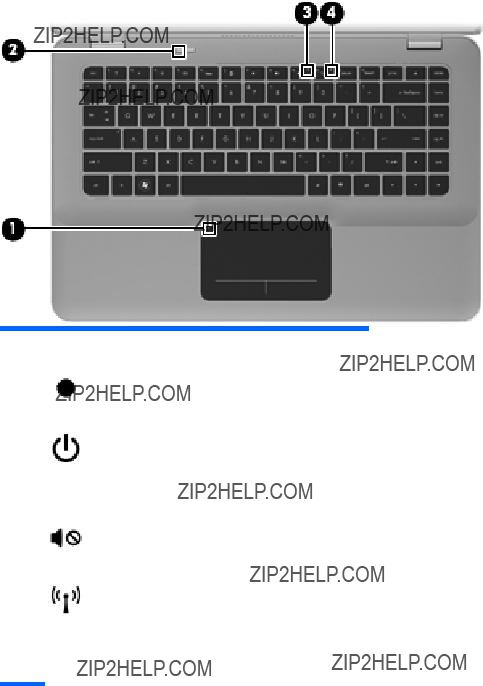
Lights
NOTE: Wireless devices are enabled at the factory.
??? Amber: All wireless devices are off.
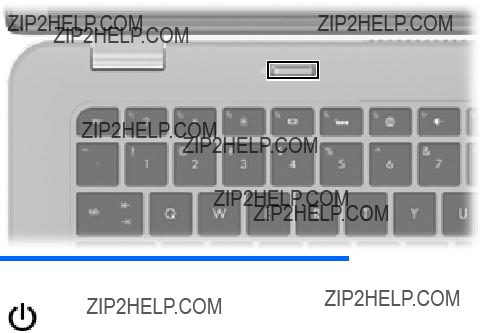
Button

Keys

Front
??? Secure Digital High Capacity Memory Card
??? Secure Digital Extended Capacity Memory Card
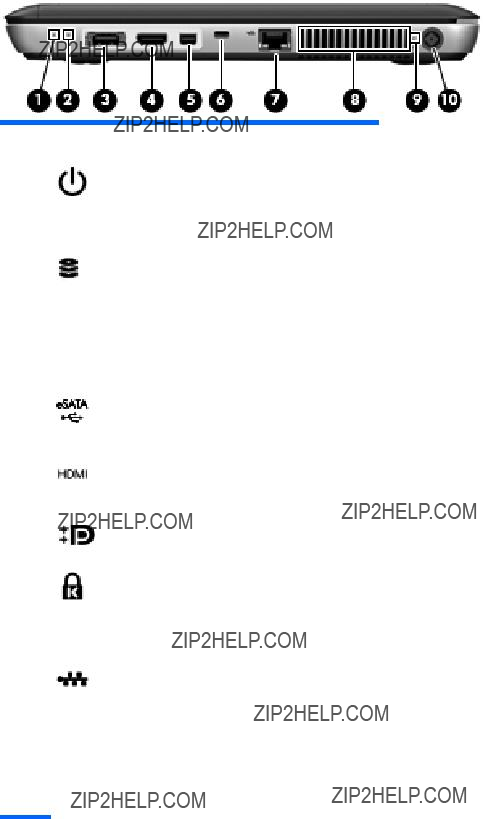
Right side
internal components and prevent overheating. It is normal for the internal fan to cycle on and off during routine operation.


Left side
WARNING! To reduce the risk of personal injury, adjust the volume before putting on headphones, earbuds, or a headset. For additional safety information, refer to the
Regulatory, Safety, and Environmental Notices.
NOTE: When a device is connected to the jack, the computer speakers are disabled.

Display
*The antennas are not visible from the outside of the computer. For optimal transmission, keep the areas immediately around the antennas free from obstructions. To see wireless regulatory notices, refer to the section of the Regulatory, Safety, and Environmental Notices that applies to your country or region. These notices are located in Help and Support.
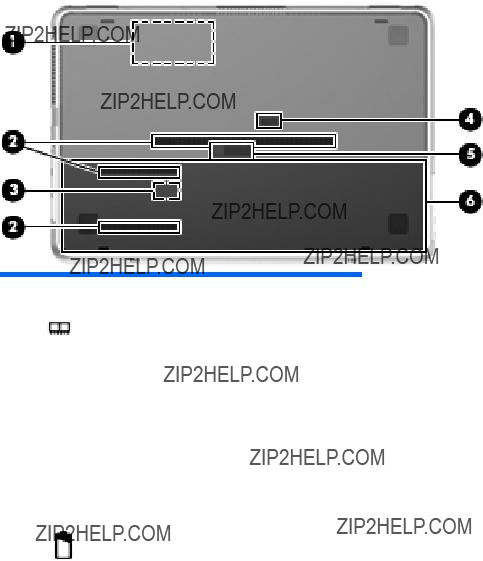
Bottom

3 Networking
 NOTE: Internet hardware and software features vary depending on computer model and your location.
NOTE: Internet hardware and software features vary depending on computer model and your location.
Your computer supports two types of Internet access:
???
???

Using an Internet service provider (ISP)
Before you can connect to the Internet, you must establish an ISP account. Contact a local ISP to purchase Internet service and a modem. The ISP will help set up the modem, install a network cable to connect your wireless computer to the modem, and test the Internet service.
 NOTE: Your ISP will give you a user ID and password to access the Internet. Record this information and store it in a safe place.
NOTE: Your ISP will give you a user ID and password to access the Internet. Record this information and store it in a safe place.
The following features will help you set up a new Internet account or configure the computer to use an existing account:
???Internet Services & Offers (available in some
???
???Windows Connect to the Internet
???You already have an account with an ISP.
???You do not have an Internet account and want to select an ISP from the list provided within the wizard. (The list of ISP providers is not available in all regions.)
???You have selected an unlisted ISP, and the ISP has provided you with information such as a specific IP address and POP3 and SMTP settings.
To access the Windows Connect to the Internet Wizard and instructions for using it, select Start > Help and Support, and then type Connect to the Internet wizard in the Search box.
 NOTE: If you are prompted within the wizard to choose between enabling or disabling Windows Firewall, choose to enable the firewall.
NOTE: If you are prompted within the wizard to choose between enabling or disabling Windows Firewall, choose to enable the firewall.
Connecting to a wireless network
Wireless technology transfers data across radio waves instead of wires. Your computer may be equipped with one or more of the following wireless devices:
???Wireless local area network (WLAN) device
???HP Mobile Broadband Module, a wireless wide area network (WWAN) device
???Bluetooth device
For more information on wireless technology and connecting to a wireless network, refer to the HP Notebook Reference Guide and information and Web site links provided in Help and Support.
Connecting to an existing WLAN
1.Turn on the computer.
2.Be sure that the WLAN device is on.

3.Click the network icon in the notification area, at the far right of the taskbar.
4.Select a network to connect to.
5.Click Connect.
6.If required, enter the security key.
Setting up a new WLAN network
Required equipment:
???A broadband modem (either DSL or cable) (1) and
???A wireless router (purchased separately) (2)
???Your new wireless computer (3)
 NOTE: Some modems have a
NOTE: Some modems have a
The illustration shows an example of a completed WLAN network installation that is connected to the Internet. As your network grows, additional wireless and wired computers can be connected to the network to access the Internet.

Configuring a wireless router
For help in setting up a WLAN, refer to the information provided by your router manufacturer or your ISP.
The Windows operating system also provides tools to help you set up a new wireless network. To use the Windows tools to set up your network, select Start > Control Panel > Network and Internet > Network and Sharing Center > Set up a new connection or network > Set up a new network. Then follow the
 NOTE: It is recommended that you initially connect your new wireless computer to the router by using the network cable provided with the router. When the computer successfully connects to the Internet, you can disconnect the cable, and then access the Internet through your wireless network.
NOTE: It is recommended that you initially connect your new wireless computer to the router by using the network cable provided with the router. When the computer successfully connects to the Internet, you can disconnect the cable, and then access the Internet through your wireless network.
Protecting your WLAN
When you set up a WLAN or access an existing WLAN, always turn on security features to protect your network from unauthorized access.
For information on protecting your WLAN, refer to the HP Notebook Reference Guide.

4 Keyboard and pointing devices
Using the keyboard
Using the action keys
Action keys are customized actions that are assigned to specific keys at the top of the keyboard.
To use an action key, press and hold this key to activate the assigned action.
 NOTE: Depending on the program you are using, pressing fn and one of the action keys opens a specific shortcut menu within that application.
NOTE: Depending on the program you are using, pressing fn and one of the action keys opens a specific shortcut menu within that application.
NOTE: You can disable the action key feature in Setup Utility (BIOS) and revert back to pressing the fn key and one of the action keys to activate the assigned action.


Using the hotkeys
A hotkey is a combination of the fn key (1) and either the esc key (2) or the b key (3).
To use a hotkey:
???Briefly press the fn key, and then briefly press the second key of the hotkey combination.

Using pointing devices
 NOTE: In addition to the pointing devices included with your computer, you can use an external USB mouse (purchased separately) by connecting it to one of the USB ports on the computer.
NOTE: In addition to the pointing devices included with your computer, you can use an external USB mouse (purchased separately) by connecting it to one of the USB ports on the computer.
Setting pointing device preferences
Use Mouse Properties in Windows?? to customize settings for pointing devices, such as button configuration, click speed, and pointer options.
To access Mouse Properties, select Start > Devices and Printers. Then,
Using the TouchPad
To move the pointer, slide one finger across the TouchPad in the direction you want the pointer to go. Use the left and right TouchPad buttons like the corresponding buttons on an external mouse.
Turning the TouchPad on and off
To turn the TouchPad on and off, quickly
Navigating
To move the pointer, slide one finger across the TouchPad in the direction you want the pointer to go.

Selecting
Use the left and right TouchPad buttons like the corresponding buttons on an external mouse.
Using TouchPad gestures
The TouchPad supports a variety of gestures. To use TouchPad gestures, place two fingers on the TouchPad at the same time.
To turn the gestures on and off:
1. in the notification area, at the far right of the taskbar, and then click the Device Settings tab.
in the notification area, at the far right of the taskbar, and then click the Device Settings tab.
2.Select the device, and then click Settings.
3.Select the gesture that you want to turn on or off.
4.Click Apply, and then click OK.
 NOTE: The computer also supports additional TouchPad features. To view and turn on these features,
NOTE: The computer also supports additional TouchPad features. To view and turn on these features,

Scrolling
Scrolling is useful for moving up, down, or sideways on a page or image. To scroll, place two fingers slightly apart on the TouchPad, and then drag them across the TouchPad in an up, down, left, or right motion.
 NOTE: Scrolling speed is controlled by finger speed.
NOTE: Scrolling speed is controlled by finger speed.
Pinching/Zooming
Pinching allows you to zoom in or out on images or text.
???Zoom in by placing two fingers together on the TouchPad, and then moving them apart.
???Zoom out by placing two fingers apart on the TouchPad, and then moving them together.

5 Maintenance
Removing or inserting the battery
 NOTE: The battery is preinstalled in the battery bay at the factory.
NOTE: The battery is preinstalled in the battery bay at the factory.
NOTE: For additional information on using the battery, refer to the HP Notebook Reference Guide.
Removing the battery
 CAUTION: Removing a battery that is the sole power source for the computer can cause loss of information. To prevent loss of information, save your work and initiate Hibernation or shut down the computer through Windows before removing the battery.
CAUTION: Removing a battery that is the sole power source for the computer can cause loss of information. To prevent loss of information, save your work and initiate Hibernation or shut down the computer through Windows before removing the battery.
1.Slide the battery cover release latch (1).
2.Slide the battery cover (2) away from the computer, and then remove the battery cover.
3.Slide the right battery release latch (1) to unlock the battery.
4.Slide the left battery release latch (2) to release the battery.
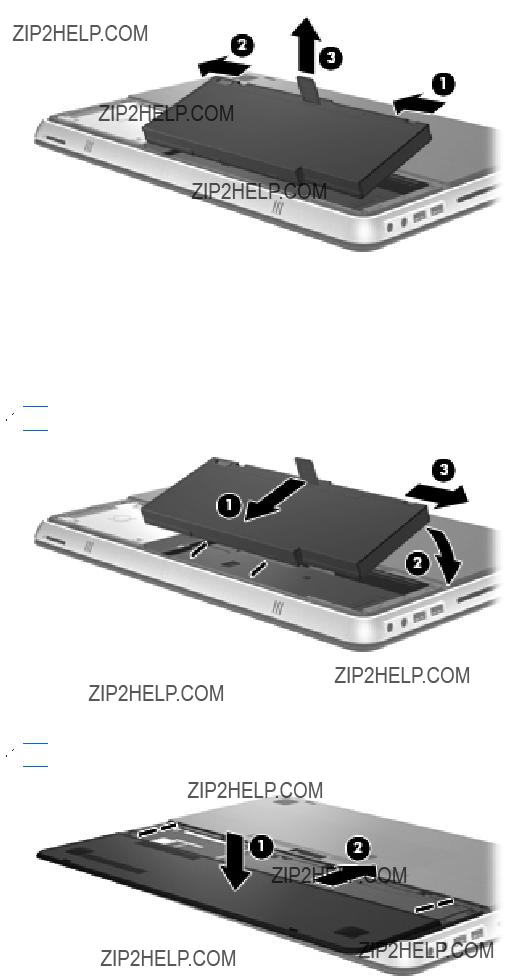
5.Pull the battery tab up (3) and remove the battery from the computer.
Inserting the battery
1.Align the tabs on the battery with the notches on the outer edge of the battery bay (1), and rotate the battery (2) into the battery bay until it is seated.
2.Slide the right battery release latch (3) to lock the battery into place.
 NOTE: The left battery release latch automatically locks into place.
NOTE: The left battery release latch automatically locks into place.
3.Replace the battery cover (1).
4.Slide the battery cover (2) to the rear until it is seated.
 NOTE: The battery cover release latch automatically locks into place.
NOTE: The battery cover release latch automatically locks into place.
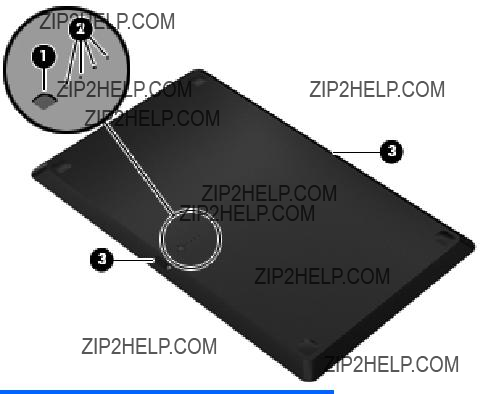
Using the accessory battery (select models only)
An accessory battery can extend the battery life of your computer.
Identifying the accessory battery components

Inserting or removing an accessory battery
To insert the accessory battery:
 NOTE: When you install the accessory battery for the first time, be sure to remove the protective cover on the accessory battery connector.
NOTE: When you install the accessory battery for the first time, be sure to remove the protective cover on the accessory battery connector.
NOTE: It is not necessary to turn off the computer before inserting or removing the accessory battery.
1.Turn the computer upside down, with the battery bay toward you.
2.Slide the battery release latches (1) on the accessory battery to unlock the battery.
3.Align the accessory battery with the bottom of the computer, with the battery fuel gauge toward you.
4.Press the accessory battery down (2) until it is seated.
 NOTE: Press down on the center of the accessory battery to be sure that the battery is connected securely to the bottom of the computer.
NOTE: Press down on the center of the accessory battery to be sure that the battery is connected securely to the bottom of the computer.
5.Slide the battery release latches (3) on the accessory battery to lock it into place on the computer.
To remove the accessory battery:
1.Slide the battery release latches (1) on the accessory battery to unlock it.
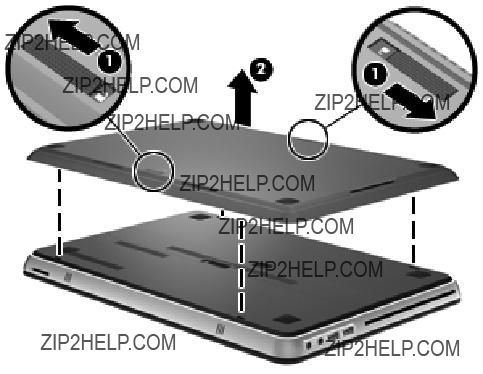
2.Lift the accessory battery (2) from the bottom of the computer.
Battery charging and discharging sequence
The battery charging and discharging sequence varies when both the primary battery and optional accessory battery are installed.
???The computer supports Fast Charge Mode (enabled at the factory). When both batteries are charging, the primary battery will charge to 90 percent before the accessory battery begins charging. Charging is then switched to the accessory battery. When the accessory battery reaches 90 percent, the primary battery will then charge to 100 percent. After the primary battery is completely charged, the accessory battery will charge to 100 percent.
???When the accessory battery reaches a critical battery level, battery power is transferred to the primary battery.
???The accessory battery will discharge before the primary battery discharges.
???When the accessory battery is removed from the computer, battery power is transferred to the primary battery.
???When the accessory battery is inserted in the computer, battery power is transferred to the accessory battery.

Replacing or upgrading the hard drive
 NOTE: The hard drive is located inside the battery bay.
NOTE: The hard drive is located inside the battery bay.
 CAUTION: To prevent information loss or an unresponsive system:
CAUTION: To prevent information loss or an unresponsive system:
Shut down the computer before removing the hard drive from the hard drive bay. Do not remove the hard drive while the computer is on, in the Sleep state, or in Hibernation.
If you are not sure whether the computer is off or in Hibernation, turn the computer on by pressing the power button. Then shut down the computer through the operating system.
Removing the hard drive
1.Save your work and shut down the computer.
2.Disconnect all external devices connected to the computer.
3.Unplug the power cord from the AC outlet.
4.Slide the battery cover release latch (1).
5.Slide the battery cover (2) away from the computer, and then remove the battery cover.
6.Remove the battery.
 NOTE: For instructions on removing the battery, refer to Removing the battery on page 27.
NOTE: For instructions on removing the battery, refer to Removing the battery on page 27.
7.Remove the hard drive screws (1).
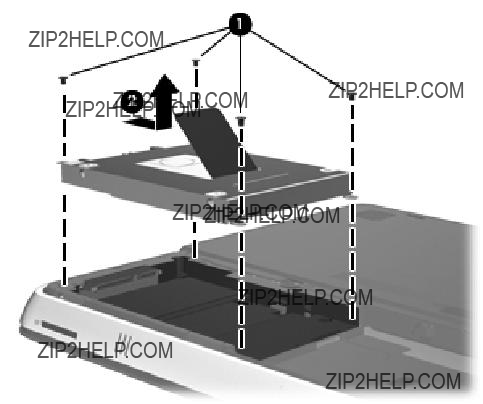
8.Slide the hard drive (2) to the right and lift it out of the hard drive bay.

Installing a hard drive
1.Insert the hard drive (1) into the hard drive bay, and then slide the hard drive to the left until it snaps into place.
2.Replace the hard drive screws (2).
3.Replace the battery.
 NOTE: For instructions on replacing the battery, refer to Inserting the battery on page 28.
NOTE: For instructions on replacing the battery, refer to Inserting the battery on page 28.
4.Replace the battery cover (1).
5.Slide the battery cover (2) to the rear until it is seated.


 NOTE: The battery cover release latch automatically locks into place.
NOTE: The battery cover release latch automatically locks into place.
6.Reconnect external power and external devices.
7.Turn on the computer.

Adding or replacing memory modules
The computer has one memory module compartment. The capacity of the computer can be upgraded by replacing the existing memory module in the primary memory module slot.
 WARNING! To reduce the risk of electric shock and damage to the equipment, unplug the power cord and remove all batteries before installing a memory module.
WARNING! To reduce the risk of electric shock and damage to the equipment, unplug the power cord and remove all batteries before installing a memory module.
 CAUTION: Electrostatic discharge (ESD) can damage electronic components. Before beginning any procedure, ensure that you are discharged of static electricity by touching a grounded metal object.
CAUTION: Electrostatic discharge (ESD) can damage electronic components. Before beginning any procedure, ensure that you are discharged of static electricity by touching a grounded metal object.
To add or replace a memory module:
 CAUTION: To prevent information loss or an unresponsive system:
CAUTION: To prevent information loss or an unresponsive system:
Shut down the computer before adding or replacing memory modules. Do not remove a memory module while the computer is on, in the Sleep state, or in Hibernation.
If you are not sure whether the computer is off or in Hibernation, turn the computer on by pressing the power button. Then shut down the computer through the operating system.
1.Save your work and shut down the computer.
2.Disconnect all external devices connected to the computer.
3.Unplug the power cord from the AC outlet.
4.Remove the battery cover and battery.
 NOTE: For instructions on removing the battery, refer to Removing the battery on page 27.
NOTE: For instructions on removing the battery, refer to Removing the battery on page 27.
5.Remove the 5 memory module compartment cover screws (1).
6.Slide the memory module compartment cover (2) to the rear, and then remove the memory module compartment cover.
7.If you are replacing a memory module, remove the existing memory module:
a.Pull away the retention clips (1) on each side of the memory module. The memory module tilts up.

b.Grasp the edge of the memory module (2), and then gently pull the memory module out of the memory module slot.
 CAUTION: To prevent damage to the memory module, hold the memory module by the edges only. Do not touch the components on the memory module.
CAUTION: To prevent damage to the memory module, hold the memory module by the edges only. Do not touch the components on the memory module.
To protect a memory module after removal, place it in an
8.Insert a new memory module:
 CAUTION: To prevent damage to the memory module, hold the memory module by the edges only. Do not touch the components on the memory module.
CAUTION: To prevent damage to the memory module, hold the memory module by the edges only. Do not touch the components on the memory module.
a.Align the notched edge (1) of the memory module with the tab in the memory module slot.
b.With the memory module at a
c.Gently press the memory module (3) down, applying pressure to both the left and right edges of the memory module, until the retention clips snap into place.
 CAUTION: To prevent damage to the memory module, be sure that you do not bend the memory module.
CAUTION: To prevent damage to the memory module, be sure that you do not bend the memory module.

9.Replace the memory module compartment cover (1) and then slide the cover to the front until it is seated.
10.Replace the 5 memory module compartment cover screws (2).
11. Replace the battery and battery cover.
 NOTE: For instructions on replacing the battery, refer to Inserting the battery on page 28.
NOTE: For instructions on replacing the battery, refer to Inserting the battery on page 28.
12.Reconnect external power and external devices.
13.Turn on the computer.
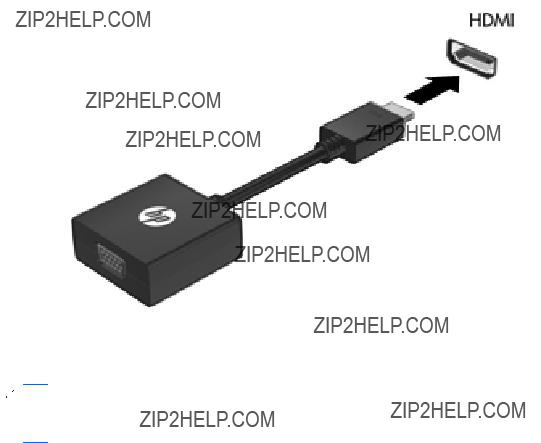
Connecting an external monitor or projector
To connect an external display such as a monitor or projector to the computer, connect the HP HDMI to VGA Display Adapter (select models only) to the HDMI port on the computer.
The HP HDMI to VGA Display Adapter supports the following resolution types:
???800 ?? 600
???1024 ?? 768
???1280 ?? 720
???1280 ?? 800
???1280 ?? 1024
???1400 ?? 1050
???1440 ?? 900
???1600 ?? 1200
???1680 ?? 1050
???1920 ?? 1080
To connect an external monitor or projector using the HDMI to VGA Display Adapter, follow these steps:
1.Connect the HDMI to VGA Display Adapter to the HDMI port on the computer.
2.Connect an external monitor or projector to the other end of the adapter.
 NOTE: If a properly connected external display device does not display an image, press the switch screen image key to transfer the image to the device. Repeatedly pressing the switch screen image key alternates the screen image between the computer display and the device.
NOTE: If a properly connected external display device does not display an image, press the switch screen image key to transfer the image to the device. Repeatedly pressing the switch screen image key alternates the screen image between the computer display and the device.
Updating programs and drivers
HP recommends that you update your programs and drivers on a regular basis. Go to http://www.hp.com/support to download the latest versions. You can also register to receive automatic update notifications when they become available.

Routine care
Cleaning the display
 CAUTION: To prevent permanent damage to the computer, never spray water, cleaning fluids, or chemicals on the display.
CAUTION: To prevent permanent damage to the computer, never spray water, cleaning fluids, or chemicals on the display.
To remove smudges and lint, frequently clean the display with a soft damp,
Cleaning the TouchPad and keyboard
Dirt and grease on the TouchPad can cause the pointer to jump around on the screen. To avoid this, clean the TouchPad with a damp cloth, and wash your hands frequently when using the computer.
 WARNING! To reduce the risk of electric shock or damage to internal components, do not use a vacuum cleaner attachment to clean the keyboard. A vacuum cleaner can deposit household debris on the keyboard surface.
WARNING! To reduce the risk of electric shock or damage to internal components, do not use a vacuum cleaner attachment to clean the keyboard. A vacuum cleaner can deposit household debris on the keyboard surface.
Clean the keyboard regularly to prevent keys from sticking, and to remove dust, lint, and particles that can become trapped beneath the keys. A can of compressed air with a straw extension can be used to blow air around and under the keys to loosen and remove debris.

6 Backup and recovery
Recovery after a system failure is as good as your most recent backup. HP recommends that you create recovery discs immediately after software setup. As you add new software and data files, you should continue to back up your system on a regular basis to maintain a reasonably current backup.
Tools provided by the operating system and HP Recovery Manager software are designed to help you with the following tasks for safeguarding your information and restoring it in case of a computer failure:
???Creating a set of recovery discs (Recovery Manager software feature)
???Backing up your information
???Creating system restore points
???Recovering a program or driver
???Performing a full system recovery (from the partition or recovery discs)
 NOTE: Recovery discs have been included if your computer does not have a partition. Use these discs to recover your operating system and software. To check for the presence of a recovery partition, click Start,
NOTE: Recovery discs have been included if your computer does not have a partition. Use these discs to recover your operating system and software. To check for the presence of a recovery partition, click Start,

Recovery discs
HP recommends that you create recovery discs to be sure that you can restore your computer to its original factory state if the hard drive fails, or if for any reason you cannot recover using the recovery partition tools. Create these discs after setting up the computer for the first time.
Handle these discs carefully and keep them in a safe place. The software allows the creation of only one set of recovery discs.
 NOTE: If your computer does not include an integrated optical drive, you can use an optional external optical drive (purchased separately) to create recovery discs, or you can purchase recovery discs for your computer from the HP Web site. If you use an external optical drive, it must be connected directly to a USB port on the computer, not to a USB port on an external device, such as a USB hub.
NOTE: If your computer does not include an integrated optical drive, you can use an optional external optical drive (purchased separately) to create recovery discs, or you can purchase recovery discs for your computer from the HP Web site. If you use an external optical drive, it must be connected directly to a USB port on the computer, not to a USB port on an external device, such as a USB hub.
Guidelines:
???Purchase
 NOTE:
NOTE:
???The computer must be connected to AC power during this process.
???Only one set of recovery discs can be created per computer.
???Number each disc before inserting it into the optical drive.
???If necessary, you can exit the program before you have finished creating the recovery discs. The next time you open Recovery Manager, you will be prompted to continue the disc creation process.
To create a set of recovery discs:
1.Select Start > All Programs > Recovery Manager > Recovery Disc Creation.
2.Follow the
Performing a system recovery
Recovery Manager software allows you to repair or restore the computer to its original factory state. Recovery Manager works from recovery discs or from a dedicated recovery partition (select models only) on the hard drive.
Note the following when performing a system recovery:
???You can recover only files that you have previously backed up. HP recommends that you use HP Recovery Manager to create a set of recovery discs (entire drive backup) as soon as you set up the computer.
???Windows has its own
???Recovery Manager recovers only software that was preinstalled at the factory. Software not provided with this computer must be downloaded from the manufacturer's Web site or reinstalled from the disc provided by the manufacturer.
Recovering using the dedicated recovery partition (select models only)
On some models, you can perform a recovery from the partition on the hard drive, accessed by clicking Start or pressing the f11 key. This type of recovery restores the computer to its factory condition without using recovery discs.
To restore the computer from the partition, follow these steps:
1.Access Recovery Manager in either of the following ways:
???Select Start > All Programs > Recovery Manager > Recovery Manager.
??? or ???
???Turn on or restart the computer, and then press esc while the ???Press the ESC key for Startup Menu??? message is displayed at the bottom of the screen. Then, press f11 while the ???F11 (HP Recovery)??? message is displayed on the screen.
2.Click System Recovery in the Recovery Manager window.
3.Follow the
Recovering using the recovery discs
1.If possible, back up all personal files.
2.Insert the first recovery disc into the optical drive on your computer or an optional external optical drive, and then restart the computer.
3.Follow the

Backing up your information
You should back up your computer files on a regular schedule to maintain a current backup. You can back up your information to an optional external hard drive, a network drive, or discs. Back up your system at the following times:
???At regularly scheduled times
 NOTE: Set reminders to back up your information periodically.
NOTE: Set reminders to back up your information periodically.
???Before the computer is repaired or restored
???Before you add or modify hardware or software Guidelines:
???Create system restore points using the Windows?? System Restore feature, and periodically copy them to an optical disc or an external hard drive. For more information on using system restore points, refer to Using system restore points on page 44.
???Store personal files in the Documents library and back up this folder periodically.
???Save customized settings in a window, toolbar, or menu bar by taking a screen shot of your settings. The screen shot can be a
Using Windows Backup and Restore
Windows Backup and Restore allows you to back up individual files or back up the entire computer image.
Guidelines:
???Be sure that the computer is connected to AC power before you start the backup process.
???Allow enough time to complete the backup process. Depending on file sizes, it may take over an hour.
To create a backup:
1.Select Start > Control Panel > System and Security > Backup and Restore.
2.Follow the
 NOTE: Windows?? includes the User Account Control feature to improve the security of the computer. You may be prompted for your permission or password for tasks such as installing software, running utilities, or changing Windows settings. Refer to Help and Support for more information.
NOTE: Windows?? includes the User Account Control feature to improve the security of the computer. You may be prompted for your permission or password for tasks such as installing software, running utilities, or changing Windows settings. Refer to Help and Support for more information.
Using system restore points
A system restore point allows you to save and name a snapshot of your hard drive at a specific point in time. You can then recover back to that point if you want to reverse subsequent changes.
 NOTE: Recovering to an earlier restore point does not affect data files saved or
NOTE: Recovering to an earlier restore point does not affect data files saved or

You also can create additional restore points to provide increased protection for your files and settings.
When to create restore points
???Before you add or extensively modify software or hardware
???Periodically, whenever the computer is functioning optimally
 NOTE: If you revert to a restore point and then change your mind, you can reverse the restoration.
NOTE: If you revert to a restore point and then change your mind, you can reverse the restoration.
Create a system restore point
1.Select Start > Control Panel > System and Security > System.
2.In the left pane, click System Protection.
3.Click the System Protection tab.
4.Follow the
Restore to a previous date and time
To revert to a restore point (created at a previous date and time), when the computer was functioning optimally, follow these steps:
1.Select Start > Control Panel > System and Security > System.
2.In the left pane, click System protection.
3.Click the System Protection tab.
4.Click System Restore.
5.Follow the

7 Customer support
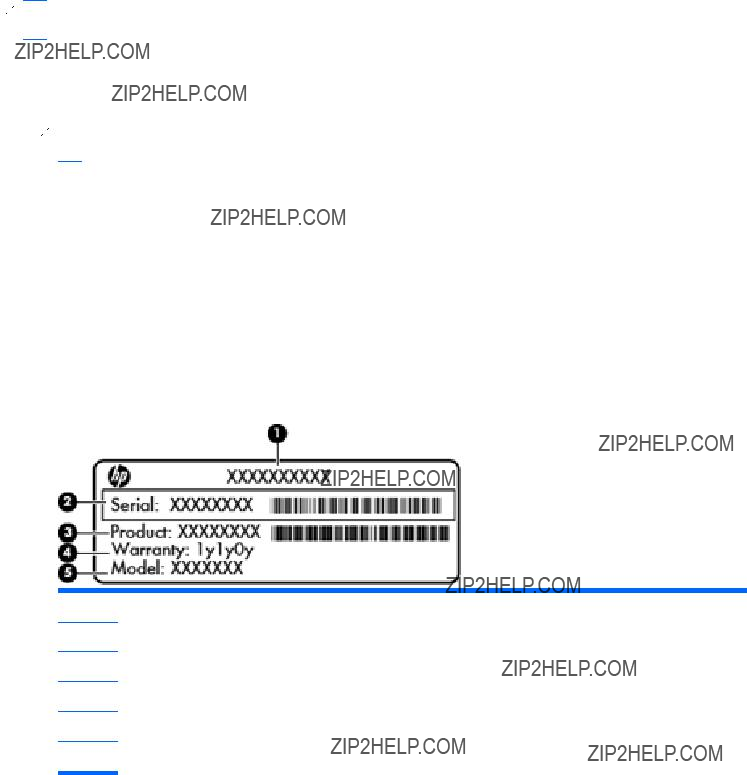
Contacting Customer Support
If the information provided in this Getting Started guide, in the HP Notebook Reference Guide, or in Help and Support does not address your questions, you can contact HP Customer Support at:
http://www.hp.com/go/contactHP
 NOTE: For worldwide support, click Contact HP worldwide on the left side of the page, or go to http://welcome.hp.com/country/us/en/wwcontact_us.html.
NOTE: For worldwide support, click Contact HP worldwide on the left side of the page, or go to http://welcome.hp.com/country/us/en/wwcontact_us.html.
Here you can:
???Chat online with an HP technician.
 NOTE: When technical support chat is not available in a particular language, it is available in English.
NOTE: When technical support chat is not available in a particular language, it is available in English.
???
???Find HP Customer Support worldwide telephone numbers.
???Locate an HP service center.
Labels
The labels affixed to the computer provide information you may need when you troubleshoot system problems or travel internationally with the computer:
???Serial number
Component
(1)Product name
(2)Serial number (s/n)
(3)Part number/Product number (p/n)
(4)Warranty period
(5)Model description
Have this information available when you contact technical support. The serial number label is located inside the battery bay.
???Microsoft?? Certificate of
???Regulatory
???Wireless certification label or labels (select models
???SIM (subscriber identity module) label (select models
???HP Mobile Broadband Module serial number label (select models

8 Specifications
Input power
The power information in this section may be helpful if you plan to travel internationally with the computer.
The computer operates on DC power, which can be supplied by an AC or a DC power source. The AC power source must be rated at
The computer can operate on DC power within the following specifications. Your computer uses one of the following adapters.
 NOTE: This product is designed for IT power systems in Norway with
NOTE: This product is designed for IT power systems in Norway with
NOTE: The computer operating voltage and current can be found on the system regulatory label located inside the battery bay.
Operating environment


Index
description 23
display system information 23 using 23
HP HDMI to VGA Display Adapter, using 38
I
input power 49 integrated webcam light,
identifying 15 internal microphones,
identifying 15
Internet connection setup 17 ISP, using 18
J jacks
K
keyboard backlight key, identifying 22
keyboard hotkeys, identifying 23 keys
action 10
